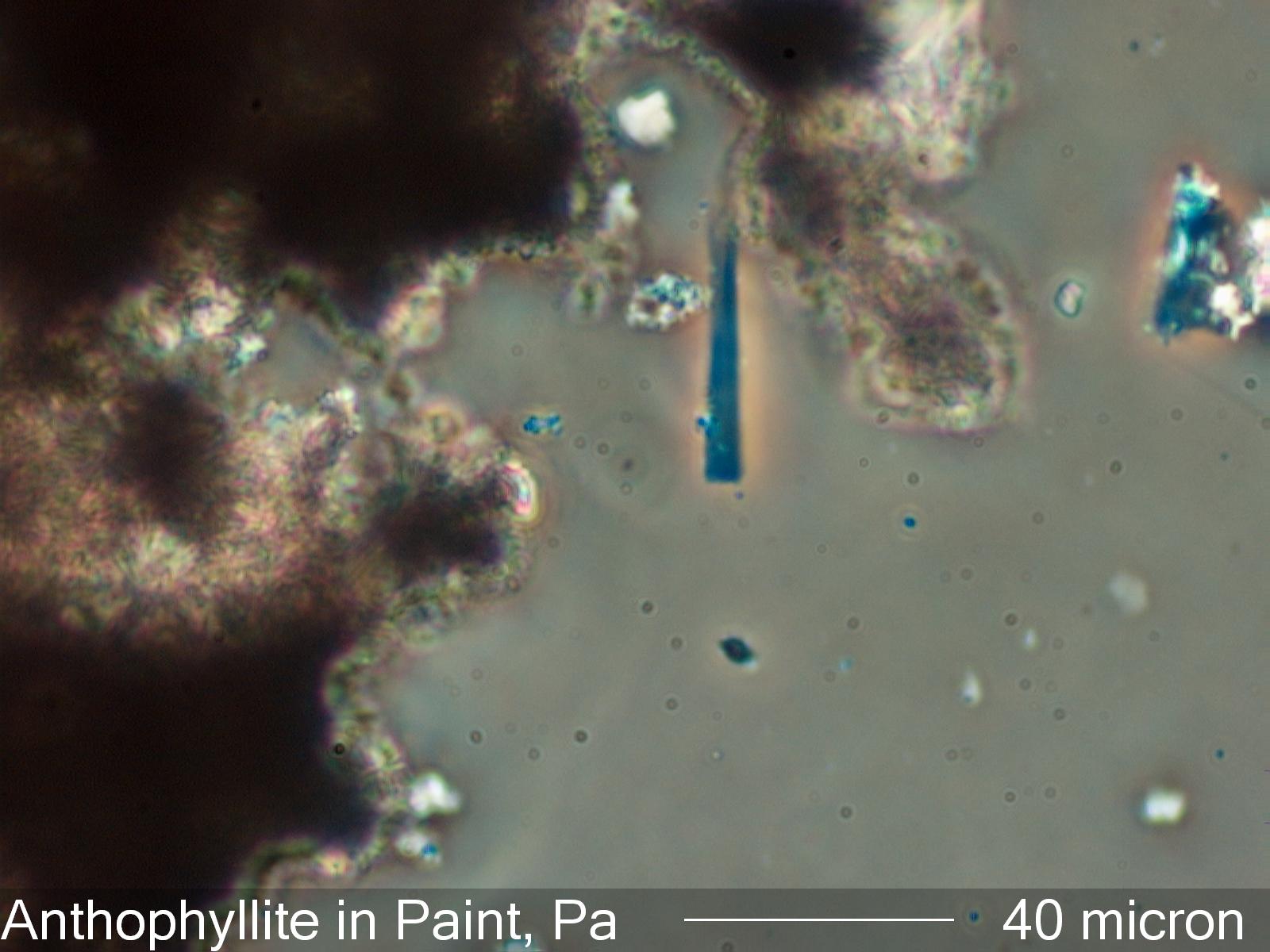Anthophyllite Asbestos
This sample is from the white paint layer on the surface of a cellulose fiber acoustic ceiling tile. The sample is mounted in high dispersion 1.605 refractive index oil and a single linear polarizing filter is oriented parallel to the length of the fiber. The wavelength match here is about 480 nanometers. That indicates a D-line refractive index for the anthophyllite of about 1.620
Transmitted Phase Contrast with a Single Linear Polarizer Parallel to the Fiber
Length
2. Campbell, W.J., R.L. Blake, L.L. Brown, E.E. Cather, and J.J. Sjoberg, IC 8751; SELECTED SILICATE MINERALS AND THEIR ASBESTIFORM VARIETIES, US Dept. of the Interior, Bureau of Mines Information Circular, 1977
3. Deer, W. A., R. A. Howie, and J. Zussman, AN INTRODCUTION TO THE ROCK-FORMING MINERALS, ISBN 0-582-30094-0, pp. 232-236, 1992
4. Ledoux, R. L. (ed), SHORT COURSE IN MINERALOGICAL TECHNIQUES OF ASBESTOS DETERMINATION, Mineralogical Association of Canada, 1979.
5. Levadie, Benjamin (ed), DEFINITIONS FOR ASBESTOS AND OTHER HEALTH-RELATED SILICATES, ASTM STP 834, 1984.
6. Riordon, P. H. (ed), GEOLOGY OF ASBESTOS DEPOSITS, Society of Mining Engineers, 1981.
7. World Health Organization, ASBESTOS AND OTHER NATURAL MINERAL FIBRES, Environmental Health Criteria 53, 1986.
Definition/Function:
Anthophyllite asbestos is a fibrous amphibole with the chemical composition (Mg, Fe)7[Si8O22](OH, F)2. It is one of the more hazardous forms of asbestos.Significance in the Environment:
Anthophyllite had a rather limited commercial use and is encountered as an impurity in talc as often as it is as an intentionally added material. In materials with a significant talc content the amount of Anthophyllite can exceed 1%.Characteristic Features:
Anthophyllite has refractive indices that overlap those of Tremolite and Actinolite asbestos but Anthophyllite always shows parallel extinction.Associated Particles:
As an impurity it is generally found with high concentrations of talc. It was used as an additive in paint and ceramics, mastics, floor tiles, acoustic tiles, and other construction materials.References:
1. Asbestos Textile Institute, HANDBOOK OF ASBESTOS TEXTILES, 3RD EDITION, 1967.2. Campbell, W.J., R.L. Blake, L.L. Brown, E.E. Cather, and J.J. Sjoberg, IC 8751; SELECTED SILICATE MINERALS AND THEIR ASBESTIFORM VARIETIES, US Dept. of the Interior, Bureau of Mines Information Circular, 1977
3. Deer, W. A., R. A. Howie, and J. Zussman, AN INTRODCUTION TO THE ROCK-FORMING MINERALS, ISBN 0-582-30094-0, pp. 232-236, 1992
4. Ledoux, R. L. (ed), SHORT COURSE IN MINERALOGICAL TECHNIQUES OF ASBESTOS DETERMINATION, Mineralogical Association of Canada, 1979.
5. Levadie, Benjamin (ed), DEFINITIONS FOR ASBESTOS AND OTHER HEALTH-RELATED SILICATES, ASTM STP 834, 1984.
6. Riordon, P. H. (ed), GEOLOGY OF ASBESTOS DEPOSITS, Society of Mining Engineers, 1981.
7. World Health Organization, ASBESTOS AND OTHER NATURAL MINERAL FIBRES, Environmental Health Criteria 53, 1986.


